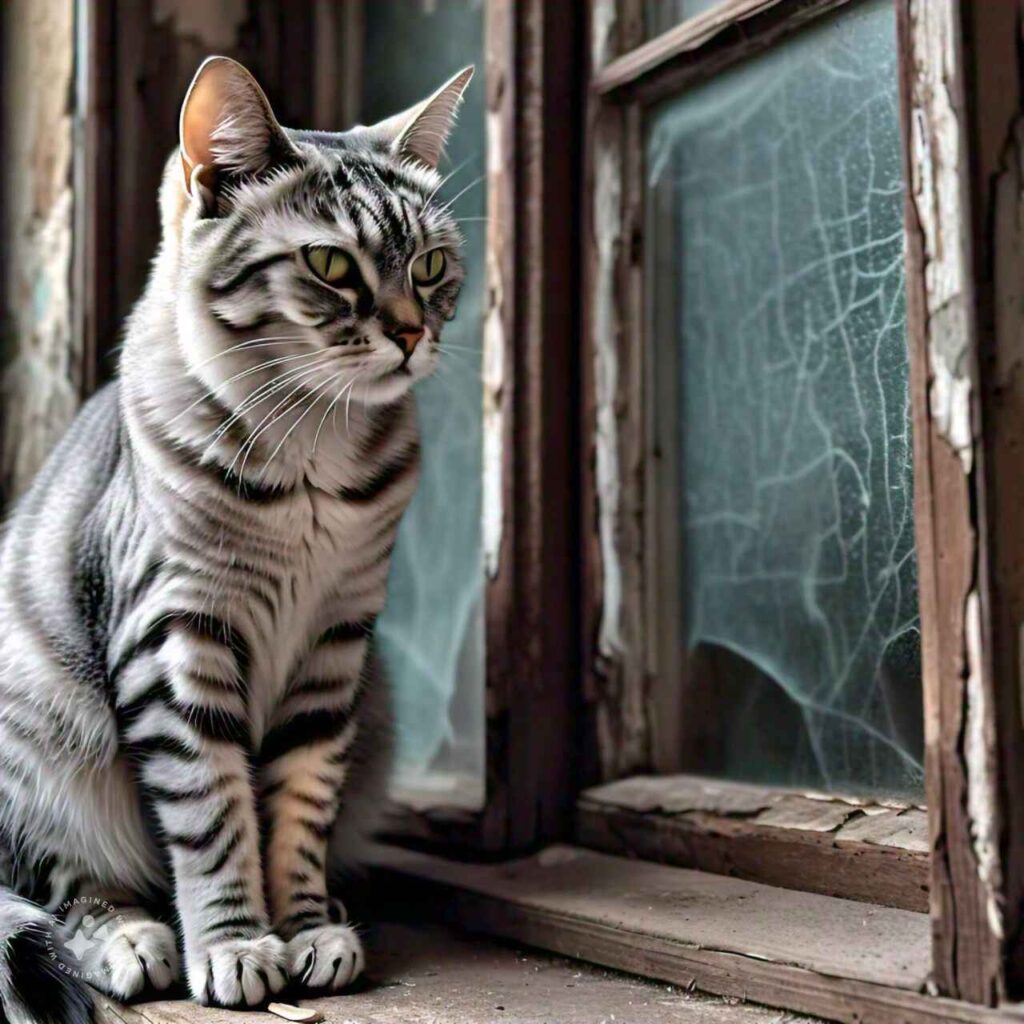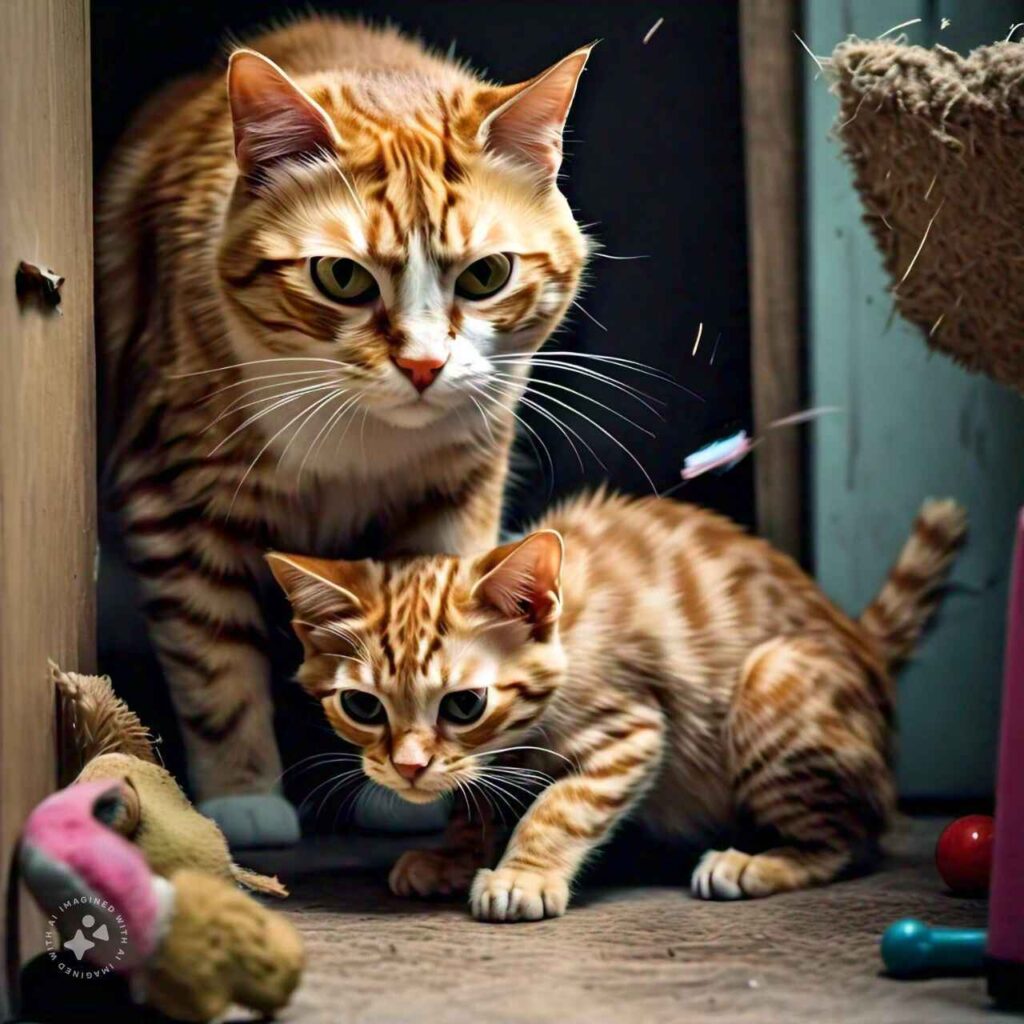1. Introduction
Sudden aggressive behavior in cats is a concerning issue for pet owners. While some level of assertiveness or defensiveness is natural for felines, unexplained hostility can indicate deeper problems. Cats, typically known for their independent demeanor, may suddenly lash out for reasons that are not immediately obvious. The key to resolving such behavior is understanding what triggers it and how to respond in a way that ensures both the safety of the cat and its owner.

Aggressive behavior in cats can range from growling, hissing, or swatting to outright attacks on people or other pets. This can occur unexpectedly and seemingly without provocation, leaving owners perplexed. Understanding the causes, signs, and strategies to address sudden aggression is essential for ensuring that both the cat and its human companions live in harmony. In this article, we will explore the types of aggression, the triggers, and the steps you can take to manage sudden aggressive behavior in cats.
Understanding Aggression in Cats
Aggression in cats is a complex behavior that can be driven by a variety of factors. To effectively manage this behavior, it’s essential to identify the type of aggression your cat is exhibiting. Each type of aggression has its own distinct set of triggers and responses, which can help in determining the best course of action.
Types of Aggression
Fear-induced Aggression**: This is the most common form of aggression in cats and occurs when they feel threatened. A cat may respond aggressively to defend itself if it believes it’s in danger. Fearful aggression is typically accompanied by signs such as flattened ears, dilated pupils, and attempts to retreat. If the cat feels cornered, it may attack.
– **Territorial Aggression**: Cats are territorial animals by nature. If they feel their space is being invaded by another animal or even a new person, they may become defensive. This type of aggression is more likely in multi-cat households or when new pets are introduced to the home.
Redirected Aggression**: Sometimes, a cat that is frustrated by an external stimulus, such as seeing another cat through a window, may redirect its aggression towards a person or another animal in the house. This can happen when the cat cannot reach the source of its frustration but still feels the need to release its pent-up energy.
Pain-induced Aggression**: Cats in pain may react aggressively when touched or moved, even if the touch was not intended to harm them. Cats with undiagnosed injuries, arthritis, or dental issues may suddenly become aggressive during routine handling.
Common Triggers
Some triggers of aggression are environmental, while others are related to the cat’s physical health or emotional state. Common triggers include:

Unfamiliar people or animals**: Cats may become hostile when new people or pets enter their home, as they perceive this as an invasion of their territory.
Loud noises**: Sudden noises can startle cats, causing them to react defensively.
Changes in routine or environment: Even small changes, such as moving furniture, can cause stress in cats and lead to aggression.
– **Invasive handling**: Cats may react aggressively if they feel they are being restrained or handled too much, especially when unwell.
—
Identifying Sudden Aggressive Behavior
Sudden aggressive behavior in cats can be unsettling, especially when it occurs without obvious provocation. To address this issue effectively, it’s important to recognize the signs early and understand how these changes manifest.
Signs to Look For
Recognizing the warning signs of aggression before it escalates into an attack is key. Cats often give clear indications when they are becoming upset or frustrated. Some of the most common signs of aggression include:
– **Hissing, growling, or yowling**: These vocalizations are clear signs that a cat is feeling threatened or irritated. Hissing is often the first sign that a cat is not happy and may escalate to more aggressive behavior if the threat continues.
Ears flattened or turned backward**: A cat that flattens its ears is trying to protect itself and is likely feeling defensive or frightened.
Raised fur along the back and tail**: Known as piloerection, this is a cat’s way of making itself appear larger in the face of a threat. A puffed-up appearance is a clear sign of fear and aggression.
Tail flicking or thrashing**: A cat that is rapidly flicking or thrashing its tail is likely feeling frustrated and is preparing to act aggressively.
Dilated pupils and tense posture**: Widened eyes and a rigid stance are indicators that the cat is on high alert and ready to react.
Behavioral Changes to Monitor
In addition to physical signs, behavioral changes can also be telling. A normally affectionate cat that suddenly becomes aloof or aggressive may be experiencing stress or discomfort. Some behavioral changes to watch for include:
Avoidance of contact**: A cat that suddenly refuses to be touched or held may be experiencing physical discomfort or emotional stress.
Swatting or biting during interaction**: If a cat that usually enjoys being petted suddenly begins swatting or biting, this may indicate pain or overstimulation.
Monitoring these signs and behaviors can help in addressing the aggression before it escalates to a dangerous level.
Causes of Sudden Aggression
Understanding the causes of sudden aggression in cats is critical for addressing the behavior effectively. There are several factors that can contribute to a cat’s aggressive outbursts, ranging from changes in its environment to health issues that need medical attention.
Environmental Factors

Changes in a cat’s environment are a common cause of sudden aggression. Cats are creatures of habit and thrive in stable, predictable environments. When their surroundings change, they may feel threatened and respond with aggression. Common environmental factors that may trigger aggression include:
– **Moving to a new home**: Relocating can be extremely stressful for cats, as they lose their familiar territory and are exposed to new stimuli.
Introducing new pets or people**: Cats may become territorial and aggressive when new pets or people enter their space. This is especially common when new cats are introduced into the home.
– **Rearranging furniture or making renovations**: Even seemingly minor changes, such as moving furniture, can upset a cat’s sense of security and trigger aggressive behavior.
Health Issues
Undiagnosed health problems are another major cause of sudden aggression in cats. When cats are in pain or discomfort, they may react defensively to protect themselves. Health-related causes of aggression include:
Arthritis**: Older cats with joint pain may become aggressive when handled, as the movement causes them discomfort.
Dental problems**: Cats with dental pain may lash out when their mouth or face is touched.
Neurological issues**: Cats with brain disorders or injuries may exhibit sudden, unpredictable aggression.
Stress and Anxiety
Cats are sensitive to stress and anxiety, which can manifest as aggression. Stress can build up over time or be caused by sudden changes, such as:
Lack of stimulation**: Cats that are bored or under-stimulated may become frustrated and aggressive.
Conflict with other pets**: Tension between cats or other pets in the household can lead to aggression.
– **Sudden changes in routine**: Cats rely on routine, and any disruption can cause stress.
By identifying the root causes of a cat’s aggression, pet owners can take the necessary steps to address the behavior and create a calmer environment for their feline friend.
5. Immediate Steps to Take
When faced with a suddenly aggressive cat, it’s crucial to respond appropriately to prevent injury and de-escalate the situation. Reacting with force or anger can exacerbate the problem, so it’s important to remain calm and patient.

Ensuring Safety for Yourself and the Cat
The first priority when dealing with an aggressive cat is ensuring the safety of both the cat and yourself. Here are some immediate steps to take:
– **Do not engage physically**: Avoid attempting to pick up or physically restrain an aggressive cat, as this can lead to injury. Give the cat space to calm down on its own.
– **Create distance**: If your cat becomes aggressive, step back and allow them to retreat to a safe space. Cats need time to cool off, and forcing interaction can lead to more hostility.
– **Do not use punishment**: Punishing a cat for aggressive behavior will only increase its fear and stress, which can worsen the aggression.
Calming Techniques
Once the immediate threat has passed, you can try some calming techniques to soothe your cat:
Speak softly and calmly**: Cats are highly attuned to tone of voice. Speaking softly can help reassure the cat that there is no threat.
Provide a safe, quiet space**: Allow your cat to retreat to a calm, quiet area where it can feel secure. A separate room with its bedding and familiar items can be a great place for your cat to decompress.
Pheromone sprays**: Using products like Feliway, which mimics natural calming pheromones, can help reduce stress and prevent further aggression.
By remaining calm and providing a safe space for your cat, you can de-escalate aggressive behavior and avoid potential injuries.
Long-term Management Strategies
Once the immediate aggression is under control, it’s important to develop long-term strategies to prevent future outbursts. Managing aggression in cats requires patience, consistency, and understanding of the cat’s needs and triggers.
Behavioral Modification Techniques
Behavioral modification can be an effective way to address aggression in cats. Some techniques to consider include:
– **Positive reinforcement**: Rewarding good behavior with treats, affection, or play can help reinforce calm and non-aggressive behavior. Avoid punishing aggression, as this can increase stress and fear in your cat.
Gradual desensitization**: If your cat’s aggression is triggered by specific situations (e.g., being around new people or pets), you can gradually desensitize your cat by exposing them to these triggers in a controlled, safe way. Over time, your cat will learn to associate the trigger with positive experiences.
Creating a Calm Environment
A calm environment is essential for reducing aggression in cats. Here are some tips for creating a peaceful home for your feline friend:
Provide plenty of hiding spaces**: Cats feel safe when they have places to retreat to when they’re feeling overwhelmed. Ensure your home has plenty of hiding spots, such as cozy beds or boxes, where your cat can relax in peace.
Reduce environmental stressors**: Loud noises, unfamiliar people, and sudden changes can all increase stress in cats. Try to minimize these stressors in your home, and give your cat plenty of time to adjust to any changes.
By focusing on long-term management strategies, you can help your cat feel more secure and reduce the likelihood of future aggressive episodes.
When to Seek Professional Help
Sometimes, managing your cat’s aggression requires more than just at-home strategies. If your cat’s behavior is severe or persistent, it’s important to seek professional help to address the issue.
Consulting a Veterinarian
A veterinarian should always be consulted when a cat’s aggression appears suddenly, as it may be a sign of an underlying medical issue. Your vet can perform a thorough examination to rule out any health problems that may be contributing to the behavior, such as pain, infection, or neurological issues. In some cases, medications may be prescribed to help manage the cat’s anxiety or aggression.
Working with Animal Behaviorists
If medical issues are ruled out, working with an animal behaviorist can be an effective way to address persistent aggression. Behaviorists are trained to assess the root causes of aggression and develop customized behavior modification plans. They may use techniques such as desensitization, counter-conditioning, and positive reinforcement to help your cat overcome aggressive tendencies.
Seeking professional help is often the best course of action for cats with severe or ongoing aggression. With the right support, even the most challenging behavior can be managed.
8. Preventative Measures
Preventing aggression in cats is far easier than addressing it after the fact. By focusing on early training, socialization, and enrichment, you can help reduce the likelihood of sudden aggression in your cat.
Training and Socialization Tips
-Early socialization**: Kittens who are socialized early tend to be more adaptable and less prone to aggression. Exposing your kitten to a variety of people, animals, and environments can help them develop confidence and reduce fear-based aggression later in life.

Gentle handling**: Teach your cat to tolerate handling from an early age. Start with short sessions of gentle petting and gradually increase the duration. Always respect your cat’s boundaries and stop if they show signs of discomfort.
Enrichment Activities for Cats
Providing mental and physical stimulation is essential for preventing boredom and frustration in cats, which can lead to aggression. Some enrichment activities to consider include:
– **Interactive toys**: Toys that mimic hunting behavior, such as laser pointers or feather wands, can help your cat burn off excess energy in a healthy way.
Puzzle feeders**: These stimulate your cat’s mind and encourage natural foraging behavior, helping to keep them mentally engaged and less likely to become aggressive out of boredom.
By focusing on prevention, you can help your cat develop healthy behaviors and reduce the risk of sudden aggression.
FAQs
Why is my cat suddenly aggressive toward me
Sudden aggression in cats can be caused by several factors, including environmental changes, stress, or underlying health problems. If your cat has experienced a disruption in their routine, encountered a new pet or person, or is feeling unwell, they may react aggressively. It’s important to observe the context of the aggression and consider recent changes in the household. A visit to the vet can help rule out medical issues such as pain or illness, which are common causes of sudden aggression.
How can I tell if my cat’s aggression is due to pain or illness?
Cats often hide pain, but sudden aggression can be a clear indicator of discomfort or illness. Look for other signs of pain, such as reluctance to move, limping, hiding, or changes in eating and grooming habits. If your normally friendly cat hisses, growls, or bites when touched in specific areas, this could signal pain. It’s crucial to have a veterinarian examine your cat to identify any underlying medical conditions.
What should I do if my cat becomes aggressive during play
Play aggression is common, especially in younger cats, and can involve biting or swatting. If your cat becomes too rough during play, it’s important to stop the interaction immediately. Avoid using your hands or feet to play with your cat, as this encourages aggressive behavior. Instead, use toys like feather wands or laser pointers to redirect their energy. If play aggression becomes a recurring issue, introducing more interactive toys or scheduled playtimes may help reduce their pent-up energy.
Can I prevent sudden aggression in my cat
Yes, prevention is possible through a combination of early socialization, training, and providing a stress-free environment. Start by socializing your cat when they are young, exposing them to different people, pets, and environments in a gentle and controlled way. Additionally, providing plenty of mental and physical stimulation through toys, puzzle feeders, and interactive games can prevent boredom, which is a common cause of aggression. A stable routine and a calm, safe environment can also minimize stress, helping to reduce the likelihood of aggressive outbursts.
When should I seek professional help for my cat’s aggression
If your cat’s aggression is severe, persistent, or poses a safety risk to people or other pets, it’s time to seek professional help. Start by consulting a veterinarian to rule out medical causes. If no health issues are found, working with a certified animal behaviorist or a vet specializing in feline behavior can be helpful. These professionals can assess the root cause of your cat’s aggression and develop a tailored behavior modification plan to address it.
Conclusion
Sudden aggression in cats is a complex issue with many potential causes, ranging from environmental changes to health problems and stress. By understanding the triggers and warning signs of aggression, cat owners can take steps to address the behavior and ensure a safe, peaceful home for both themselves and their pets. Whether through behavioral modification, creating a calm environment, or seeking professional help, there are many strategies available to manage and prevent aggression in cats. With patience and consistency, it is possible to help your cat overcome aggressive tendencies and live a happier, more harmonious life
